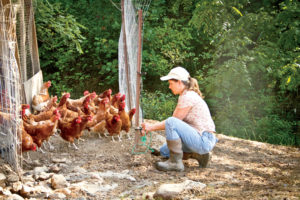Farm Marketing: Reaching A Hungry Public
East Fork Farm in Madison County, N.C., earns 90% of its revenues from farmers markets. To stand out from other vendors, farmers Stephen and Dawn Robertson hand out samples and provide recipe cards. “When I give someone a sample and...
Farm Marketing: Reaching A Hungry Public
East Fork Farm in Madison County, N.C., earns 90% of its revenues from farmers markets. To stand out from other vendors, farmers Stephen and Dawn Robertson hand out samples and provide recipe cards. “When I give someone a sample and...East Fork Farm in Madison County, N.C., earns 90% of its revenues from farmers markets. To stand out from other vendors, farmers Stephen and Dawn Robertson hand out samples and provide recipe cards.
“When I give someone a sample and a recipe card, I sell double,” says Dawn. “It takes the burden off of them to figure out how to use our products.”

Dawn Robertson looks after chickens.
Until 2013, the couple sold their eggs, chicken and lamb at four markets per week. Sales were great, but the commitment left the couple burned out and struggling to keep up with farm chores. To maximize revenues and minimize their off-farm commitments, the Robertsons dropped down to one weekend market and built a farm store.
Dawn turned to social media to build buzz about the farm, sharing photos and updates on Facebook and Instagram, and started sending a monthly newsletter with information about product availability.“People want to know what’s happening on the farm,” she says. “It’s a new way for us to market our proteins.”
Digital media is an important tool in connecting with customers, as are other technologies, such as electronic payment options and SNAP/WIC benefits. Programs like Community Supported Agriculture (CSA) and mobile farmers markets have also been embraced by producers.
But such new methods of reaching customers are not for everyone. Some farmers, such as Ron Thompson of Rockwood, Ontario, stick to the basics.
Thompson doesn’t have a web site or social media presence to market the squash, green beans, Brussels sprouts, beets, Swiss chard and other vegetables he grows on his 9-acre farm in Rockwood, Ontario. He doesn’t send newsletters with updates about what he’s bringing to market.
Thompson is still marketing his vegetables the same way he did in the 1970s. “I go to the farmers market on Saturday mornings,” he explains.
Thompson has been loading his pickup truck with fresh produce and driving 45 minutes to the Brampton Farmers Market for almost four decades. In the early years, he harvested less produce and sold to fewer customers. Now, he’s racing to keep up with demand at the bustling market. “I haven’t changed what I’m doing, but, all of a sudden, the market is packed and people can’t wait to get farm-fresh vegetables,” says Thompson.
Regardless of the advent of new opportunities, Thompson believes that effective farm marketing comes down to one thing: “You have to raise a good product,” he says. “Without a good product, you might sell to a customer once, but you’ll never sell to them again.”



